When icy winds are bearing down, the family of space heaters (FOSH) may be all that stands between you and Old Man Winter. Question is, can the FOSH depend on
you to keep them operating?
Choosing a Heater
First, you’ll need the right heater. Click on the image below to open a brief PDF guide to the various types of space heaters.
 Click on image above to open PDF
Click on image above to open PDF
FOSH Operation
To operate your heater from an external fuel supply, you’ll need hoses, a gravity feed adapter, a 5-gal fuel can and a fuel can stand. Each one demands your attention to assure safe fueling:
- Inspect fuel hoses for dry rot, cracks, cuts, wear and leaks. Replace them if necessary.
- Keep hoses’ quick- disconnect fittings clean and unblocked. Brush off snow and ice. They block fuel flow. Wipe off dirt, sand and debris. They can cut O-rings and cause fuel leaks.
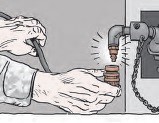 Keep quick-disconnects clean
Keep quick-disconnects clean
- Inspect the O-rings. Make sure they’re not cracked, cut or flattened.
- Run the fuel overflow hose outside, away from the tent and slightly downhill. Put the end of the hose on a petroleum absorbent mat, NSN 7930-01-363-8631, to absorb fuel overflows. That NSN brings a hundred 15x20-in sheets.
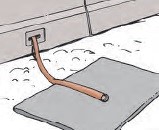 Put end of fuel overflow hose on petroleum absorbent mat
Put end of fuel overflow hose on petroleum absorbent mat
- Take care when you screw the gravity feed adapter onto the fuel can. Screw it on slow and easy so you don’t strip the can’s plastic threads. Stripped threads lead to fuel leaks and fires. Take a close look at the adapter and make sure it hasn’t been cross-threaded.
- Open flames or sparks can ignite the external fuel supply. Set up the fuel supply on a cleared, level site about seven (7) to eight (8) feet away from the tent.
- Make sure the fuel can stand is stable. Untangle the tripod straps. Fully extend the tripod legs. Tighten the hook-and-pile straps to hold the fuel can to the stand.
 Make sure fuel can stand is stable
Make sure fuel can stand is stable
- Store spare fuel cans outside of tents and shelters.
- Keep your eyes peeled for leaks— especially from the hoses, fuel can, gravity feed adapter and quick disconnects.
- Never try to fuel a hot space heater. You risk a fire or explosion. Instead, shut down the heater and allow it to cool completely before fueling from an external supply.
- Use only the approved fuels listed in your TM. Unapproved fuels—like gasoline, JP-4 or a mixture of fuels—pose a fire hazard.
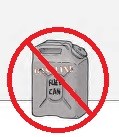 Use approved fuels only
Use approved fuels only
Lid
(Arctic and H-45 heaters only)
Close the lid when the heater’s operating. The heater doesn’t work efficiently when the lid’s open. It gives off less heat. An open lid also lets flames exit the heater.
Fire/Carbon Monoxide Prevention
(Arctic, H-45 and small heaters only)
To prevent fires or carbon monoxide buildup, apply the following:
- Use all the pipes when putting together the exhaust stack and make sure they fit snugly. Look for cracks, bent flanges or broken seams that can reduce the airflow needed to burn the fuel. Replace all damaged pipes. Check inside the pipes for clogs or soot build-up that might prevent venting. Clean out any buildup.
 Use all pipes when putting together exhaust stack
Use all pipes when putting together exhaust stack
- Attach the stack cap.
- Tie the guy lines from the cap to stakes in the ground.
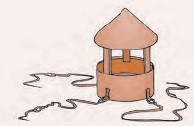 Stack cap
Stack cap
- Make sure the stack is straight up through the exhaust opening and above the tent’s peak.
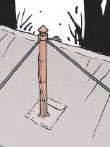 Make sure stack is straight up
Make sure stack is straight up
- Allow enough space between the heater and the tent wall. See your heater’s TM for guidelines.
- If the tent has a fabric floor or is pitched on snow, put the heater in a box of sand or on a bed of bricks.
 Put heater on box of sand
Put heater on box of sand
- Keep all flammable material at least two feet away from the heater.
- Wait until the heater cools before attempting a re-light. Re-lighting a hot heater could cause a fire or explosion.
- Before burning liquid fuel in the Arctic space heater, remove the solid fuel grate, install the burner cover and latch the front door. That helps the heater work efficiently and produce more heat. It also keeps flames from exiting the heater.
Overfiring
(Arctic and H-45 heaters only)
To prevent overfiring, adjust the fuel flow control valve. Set the fuel selector control for outside temperature and type of fuel. Adjust the fuel flow adjustment knob to regulate the amount of fuel to the burner.
When you’re not using the heater, store the fuel flow control valve in a plastic bag to protect the fuel fitting. Store it with the ON/OFF control in the ON position. That keeps the needle inside the valve from sticking closed.